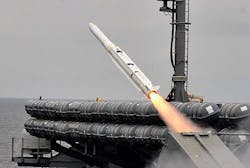Raytheon moves to full-scale development of RIM-162 ESSM Block 2 ship-defense missile
Officials of the U.S. Naval Sea Systems Command in Washington announced a $517.3 million contract to the Raytheon Missile Systems segment in Tucson, Ariz., earlier this month for full-scale development of the RIM-162 Evolved Seasparrow Missile (ESSM) Block 2. RIM stands for radar intercept missile.
The ESSM Block 2, scheduled for deployment with the Navy and allied navies in 2020, is a ship self-defense missile with a dual-mode X-band radar seeker than can engage enemy planes and missiles at ranges beyond 25 miles.
The contract is for ESSM Block 2 engineering and manufacturing development (EMD), which is the last development phase before full-scale production.
Related: Raytheon awarded $233 million production contract for evolved SEASPARROW missile
This contract will procure all necessary efforts to design, qualify, and test ESSM Block 2 and prepare the program for a successful ‘Milestone C’ decision, currently planned in 2018, Navy officials say.
Compared with its ESSM Block 1 predecessor, the ESSM Block 2 missile will have increased maneuverability and other enhancements that will enable it to defeat future threats to U.S. and allied navies operating in hostile environments, Raytheon officials say. The ESSM Block 2’s active seeker will support terminal engagement without the launch ship’s target illumination radars.
In addition to the U.S. Navy, the governments of Australia, Belgium, Canada, Denmark, Germany, Greece, The Netherlands, Norway, Portugal, Spain, and Turkey will operate ESSM Block 2.
ESSM is a medium-range, semi-active homing missile that makes flight corrections via radar and midcourse data uplinks. The missile provides reliable ship self-defense capability against agile, high-speed, low-altitude anti-ship cruise missiles, low velocity air threats like helicopters, and high-speed, maneuverable surface threats.
Related: How vulnerable are U.S. Navy vessels to advanced anti-ship cruise missiles?
The missile is 12 feet long and has 10-inch-diameter control and rocket motor sections that tapper to an 8-inch-diameter guidance section with a radome-protected antenna for semi-active homing and a warhead. It has a high-thrust, solid-propellant rocket motor and tail control via a thrust vector controller.
The first production ESSM Block 1 was delivered in late 2002 and has been in full operational use in the U.S. since 2004.
Raytheon will do the work on this contract in Tucson, Ariz.; Norway; McKinney, Texas; Australia; The Netherlands; Canada; Germany; Turkey; Andover, Mass.; San Marco, San Diego, and San Jose, Calif; Cincinnati; Canton, N.Y.; Greece; Denmark; and other locations, and should be finished by May 2019.
For more information contact Raytheon Missile Systems online at www.raytheon.com, or Naval Sea Systems Command at www.navsea.navy.mil.
